Topics
Category
Era
Minneapolis Sound (music genre)
Autographed photo of James “Jimmy Jam” Harris III (left) and Terry Lewis (right), ca. 1990. Used by Flyte Tyme Productions, Inc., Minneapolis.
The Minneapolis Sound is a music genre popularized by Prince and his many side bands, including Morris Day and The Time, the Family, Vanity 6, and Apollonia 6, as well as Jimmy Jam and Terry Lewis (working most notably with Janet Jackson) and the Jets. The Minneapolis Sound defined the sonic landscape of the 1980s and 1990s with its heavy punk- and rock-guitar solos, hard-driving, funky bass lines, and synth-forward, new-wave pop sensibilities. In the twenty-first century, it continues to influence artists like Janelle Monáe, Lizzo, Bruno Mars, and Brittany Howard.
The unique blending of musical styles that became the Minneapolis Sound has its foundations in the geography, demography, and culture of its namesake city. Racial housing covenants concentrated African Americans into the Northside and Southside neighborhoods, where the artists associated with it grew up; the white rock music dominating the radio airwaves influenced their sound aesthetic; and the strong Minneapolis school-music programs taught by Jimmy Hamilton educating them in the business of music and music theory. But perhaps the most crucial ingredient in the development of the Minneapolis Sound was the community center The Way. Created after the civil unrest in the Near North neighborhood in 1966 and 1967, The Way was the cornerstone of local arts and music. Musically inclined kids from the Northside such as Prince, Terry Lewis, Morris Day, and André Cymone hung out with local musicians like Pierre Lewis and Sonny Thompson. They absorbed the rhythm and blues, soul, and funk grooves of the house band the Family, while playing on instruments The Way provided. They then took their skills to the street, playing in Battles of the Bands throughout the city.
While these young artists were honing their musical skills, another key ingredient of the genre’s unique sounds developed. In the 1970s, the LinnDrum machine and Polymoog synthesizers revolutionized the sonic landscape of popular music. Even folk singer Cat Stevens experimented with these instruments on his pioneering pop-synth album Izitso (1977), partially recorded at Minneapolis’s premier recording studio, Sound 80. At the same time, a young, local musical prodigy named Prince Rogers Nelson was also recording in the studio, “got hip to Polymoogs,” and became a master of the drum machine. Prince, and then, later, James “Jimmy Jam” Harris III and Terry Lewis, infused these emerging technologies into their funk, rock, soul, punk, and new wave sensibilities to create a layered, complex synthesis of music never heard before.
The 1980s were the heyday of the Minneapolis Sound. Prince’s popularity grew with each album he released that decade—Dirty Mind (1980), Controversy (1981), and 1999 (1982)—and his striking looks, fashion, and dancing spurred MTV to play his videos in heavy rotation. He was such a prolific artist that he wrote more songs that his record label allowed him to release, so he created numerous side projects with artists like Morris Day and the Time (which included Jimmy Jam and Terry Lewis), Jill Jones, and Sheila E. With no Number One hits and only one Top Ten album (1999), Prince pitched the idea of a major motion picture to accompany his fifth album to his label, Warner Bros. The movie and album Purple Rain were released in 1984 and were instant hits, making Prince an international superstar and putting Minneapolis on the musical map. During the last half of the 1980s and throughout the rest of his life, Prince continued to explore new musical styles, and to evolve the Minneapolis Sound.
After being fired by Prince in 1983, Jimmy Jam and Terry Lewis started Flyte Tyme Productions and opened a recording studio in South Minneapolis. The songwriting and producing duo had success with the Human League and S.O.S., but it was their work with Janet Jackson in the mid-1980s that catapulted them and their version of the Minneapolis Sound into worldwide fame. Infusing their New Jack Swing with Jackson’s neo-soul innovations, the trio went on to create numerous hit albums throughout the early 2000s. Jam and Lewis are among the most successful songwriting and producing duos of all time.
Another popular Minneapolis Sound band was The Jets—eight Tongan American siblings who had attended Robbinsdale Cooper High School together. Having started out as a family band in 1977, they released the hit “Crush On You” in 1986 and performed on three subsequent world tours.
Bibliography
Bream, Jon. “Jam & Lewis Say Tyme’s Ryte For New Studio To Take Flyte.” Billboard, October 14, 1989.
——— . “Pop Music: The Rhythm ’n’ Blues Brothers: Jimmy Jam and Terry Lewis Are in Tune with LA and New York Music Scenes—But Keep Churning Out Their Hits From Minnesota.” Los Angeles Times, June 28, 1991.
Cragg, Michael. “The Velvet Rope: How Janet Jackson Inspired An Entire Generation.” The Guardian, October 6, 2017.
https://www.theguardian.com/music/2017/oct/06/velvet-rope-how-janet-jackson-inspired-whole-generation
Harris III, James “Jimmy Jam.” Oral history interview (A2013.353) with Larry Crowe, December 19, 2013. The HistoryMakers Digital Archive. [See especially session 1, tape 1, story 1; and session 1, tape 3, stories 1–7.]
https://www.thehistorymakers.org/biography/james-jimmy-jam-harris-iii
McAdams, Janine. “Jam & Lewis Unveil Their New Recording Complex: Flyte Tyme Studio Lands in Minneapolis.” Billboard, September 30, 1989.
Partridge, Kenneth. “Jimmy Jam Opens Up About the Making of Janet Jackson's 'Rhythm Nation 1814.’” Billboard.com, September 18, 2019.
https://www.billboard.com/articles/news/6258728/jimmy-jam-janet-jackson-rhythm-nation-1814
Prince and Dan Piepenbring, ed. The Beautiful Ones. New York: Spiegel & Grau, 2019.
Roise, Charlene, Elizabeth Gales, Kristen Koehlinger, Kathryn Goetz, and Kristen Zschomler.
Music History, 1850–2000: A Context.” Prepared for the City of Minneapolis, December 2018.
https://www.minneapolismn.gov/resident-services/property-housing/preservation/historic-preservation/theme-studies/music-history
Swensson, Andrea. Got to Be Something Here: The Rise of the Minneapolis Sound. Minneapolis: University of Minnesota Press, 2017.
Twin Cities Funk and Soul newspaper, multiple issues.
https://secretstashrecords.com/news/TwinCitiesFunkAndSoulNewspaperWeb.pdf
Zschomler, Kristen. “Prince, 1958–1987: Multiple Property Document Form.” State Historic Preservation Office, St. Paul.
https://mn.gov/admin/assets/Prince%20MPDF_tcm36-445058.pdf
Related Resources
Primary
Beaulieu, Allen. Prince: Before the Rain. St. Paul: Minnesota Historical Society Press, 2018.
Chamblis, Charles, and Davu Seru. Sights, Sounds, and Soul: The Twin Cities Through the Lens of Charles Chamblis. St. Paul: Minnesota Historical Society Press, 2017.
Related Audio
“Uptown” by Prince
Excerpt from the song “Uptown,” from Prince’s 1980 album Dirty Mind.
Articles
“Jungle Love” by Morris Day and The Time
Excerpt from the song “Jungle Love,” from Morris Day and The Time’s 1983 album Ice Cream Castle.
Articles
“Crush on You” by the Jets
Excerpt from the song “Crush on You,” from the Jets’ self-titled 1985 album.
Articles
“Escapade” by Janet Jackson
Excerpt from the song “Escapade,” from Janet Jackson’s 1989 album Rhythm Nation 1814.
Articles
Related Images
The band Cohesion plays outside of The Way community center in Minneapolis. Pictured are (left to right): Vernon Tinsley, Ricardo DeJesus, Dwayne White, Ronnie Robins, and Douglas Benton. Photograph by Charles Chamblis, undated but ca. 1975–1980. Used with the permission of the Minnesota Historical Society library.
Flyt Tyme (later spelled Flyte Tyme) in performance at The Flame in Minneapolis. Pictured are: David Eiland, aka Batman (black outfit, saxophone); Garry “Jellybean” Johnson (in yellow); Terry Lewis; Kyle Ray (far left); and Pierre Lewis (in red). Photograph by Charles Chamblis, ca. 1975–1980. Used with the permission of the Minnesota Historical Society library.
The band Flyte Tyme, and friends, in Halloween costumes: Terry Lewis (in silver with arms outstretched), Cynthia Johnson (bottom center), and Jellybean Johnson (back right). Photograph by Charles Chamblis, ca. 1980. https://www.mnhs.org/search/collections/record/542d0884-061a-4226-b6dc-e0a3ace16f17
Myst, later known as Best Kept Secret. Pictured are (front, left to right) Kathleen Johnson, Kym/Mocha Johnson, and Rhonda Johnson with the band Network, including Kirk Johnson (back row, red bow tie). Photograph by Charles Chamblis, ca. 1985. Used with the permission of the Minnesota Historical Society library.
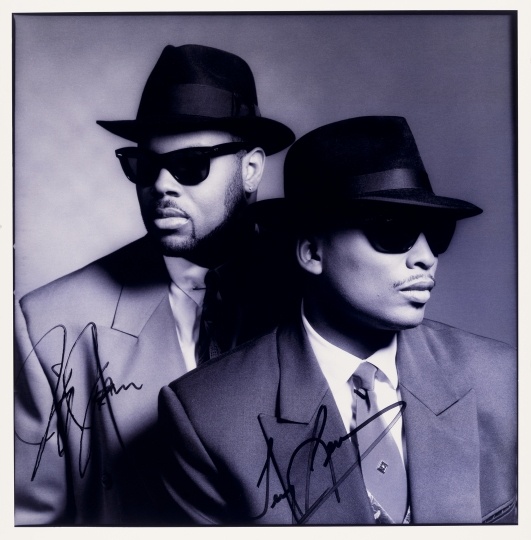
Jimmy Jam and Terry Lewis
Autographed photo of James “Jimmy Jam” Harris III (left) and Terry Lewis (right), ca. 1990. Used by Flyte Tyme Productions, Inc., Minneapolis.
Holding Location
Articles
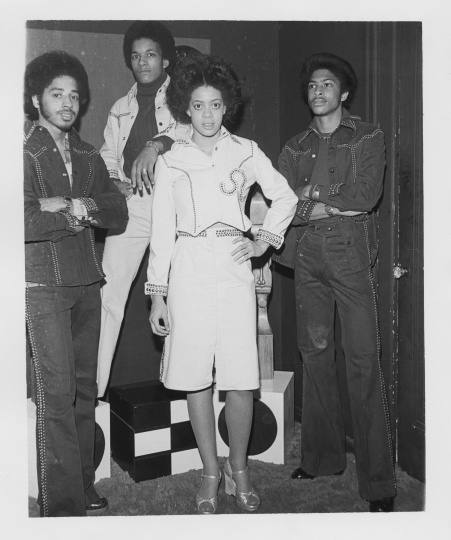
Morris Day, William Doughty, Linda Renee Anderson, and André Cymone
Morris Day, William Doughty, Linda Renee Anderson, and André Cymone. Photograph by Charles Chamblis, ca. 1975. Used with the permission of the Minnesota Historical Society library.
Holding Location
Articles
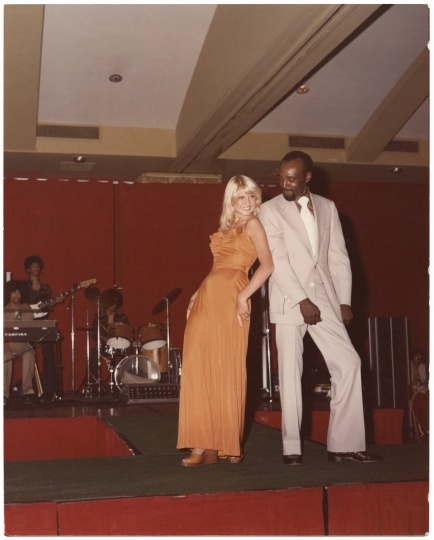
Grand Central
Fashion show with Grand Central performing: Prince (keyboards), André Cymone (bass), and Morris Day (drums). Photograph by Charles Chamblis, ca. 1975. Used with the permission of the Minnesota Historical Society library.
Holding Location
Articles
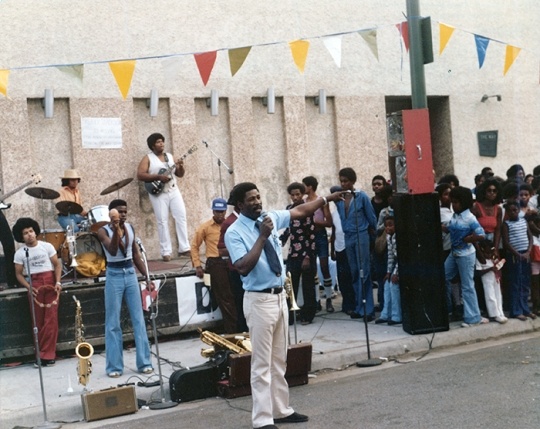
Cohesion performing outside The Way
The band Cohesion plays outside of The Way community center in Minneapolis. Pictured are (left to right): Vernon Tinsley, Ricardo DeJesus, Dwayne White, Ronnie Robins, and Douglas Benton. Photograph by Charles Chamblis, undated but ca. 1975–1980. Used with the permission of the Minnesota Historical Society library.
Holding Location
Articles
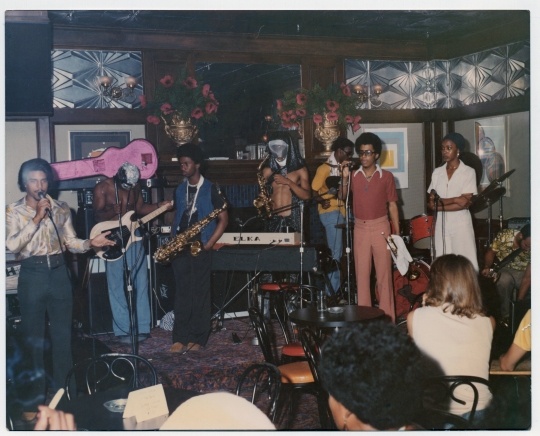
Flyt Tyme in performance at The Flame
Flyt Tyme (later spelled Flyte Tyme) in performance at The Flame in Minneapolis. Pictured are: David Eiland, aka Batman (black outfit, saxophone); Garry “Jellybean” Johnson (in yellow); Terry Lewis; Kyle Ray (far left); and Pierre Lewis (in red). Photograph by Charles Chamblis, ca. 1975–1980. Used with the permission of the Minnesota Historical Society library.
Holding Location
Articles
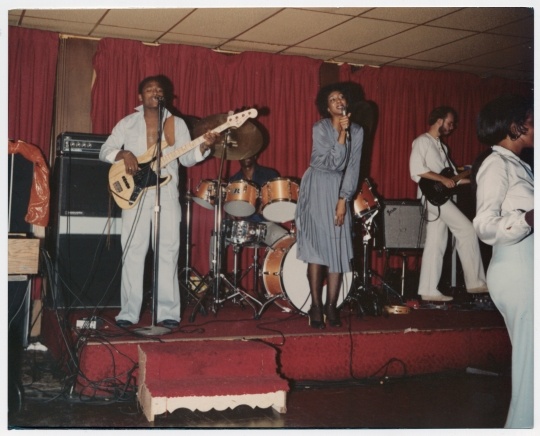
Terry Lewis, Cynthia Johnson, and Garry “Jellybean” Johnson
Terry Lewis (bass); Cynthia Johnson (lead singer, blue dress); Tony (in white, far right); and Garry “Jellybean” Johnson (drums). Photograph by Charles Chamblis, ca. 1975–1980. Used with the permission of the Minnesota Historical Society library.
Holding Location
Articles
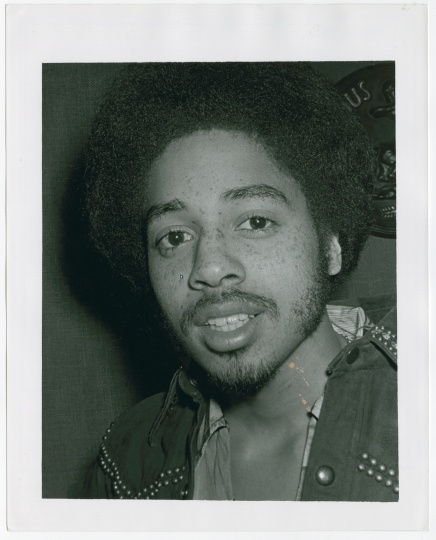
Morris Day
Morris Day. Photograph by Charles Chamblis, ca. 1975–1980. Used with the permission of the Minnesota Historical Society library.
Holding Location
Articles
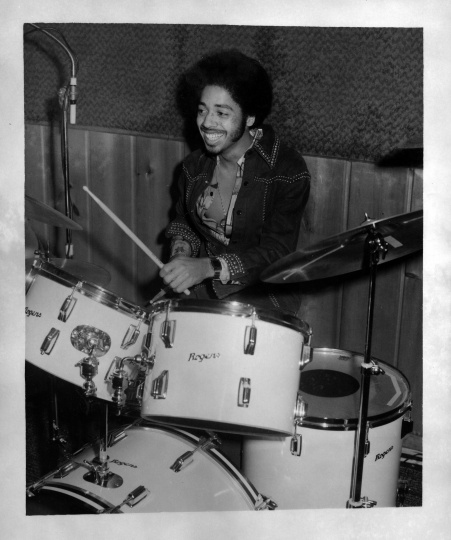
Morris Day on drums
Morris Day on drums. Photograph by Charles Chamblis, ca. 1980. Used with the permission of the Minnesota Historical Society library.
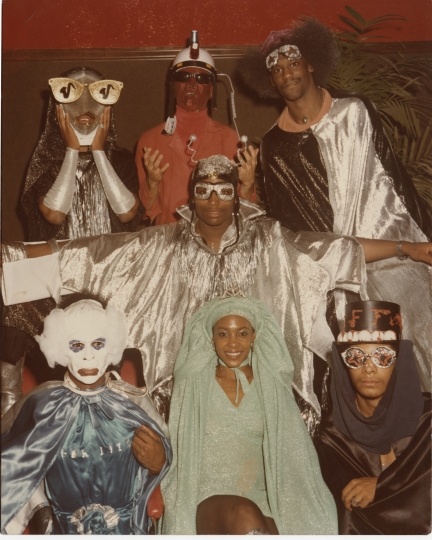
Flyte Tyme
The band Flyte Tyme, and friends, in Halloween costumes: Terry Lewis (in silver with arms outstretched), Cynthia Johnson (bottom center), and Jellybean Johnson (back right). Photograph by Charles Chamblis, ca. 1980. https://www.mnhs.org/search/collections/record/542d0884-061a-4226-b6dc-e0a3ace16f17
Holding Location
Articles
More Information
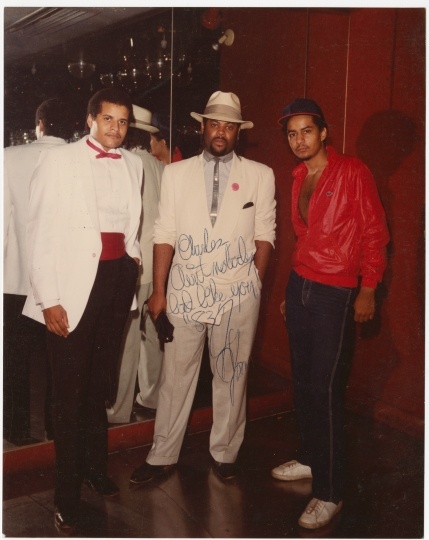
Jimmy Jam with friends
James “Jimmy Jam” Harris III (center) with friends. Photograph by Charles Chamblis, ca. 1980. Used with the permission of the Minnesota Historical Society library.
Holding Location
Articles
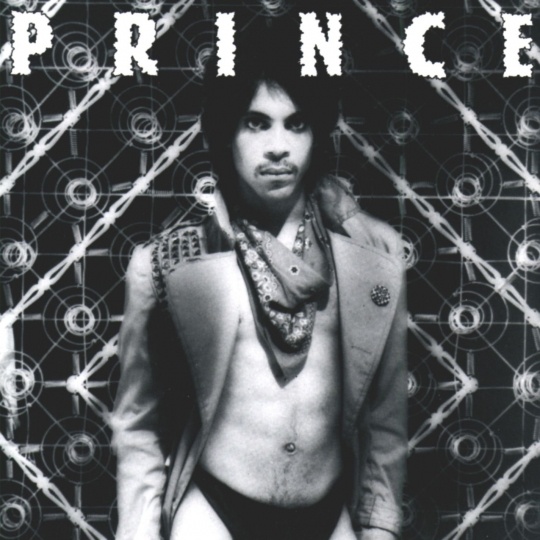
Dirty Mind album cover
The cover of Prince’s 1980 album Dirty Mind. Photograph by Allen Beaulieu.
Holding Location
Articles
More Information
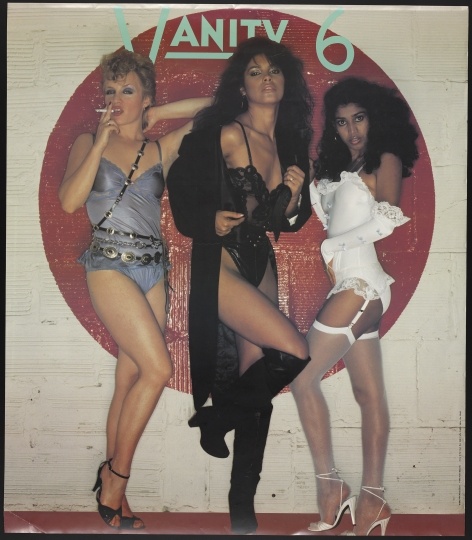
Vanity 6 poster
Vanity 6 poster, ca. 1982. Pictured are (left to right): Brenda Bennett, Vanity (Denise Matthews), and Susan Moonsie.
Holding Location
Articles
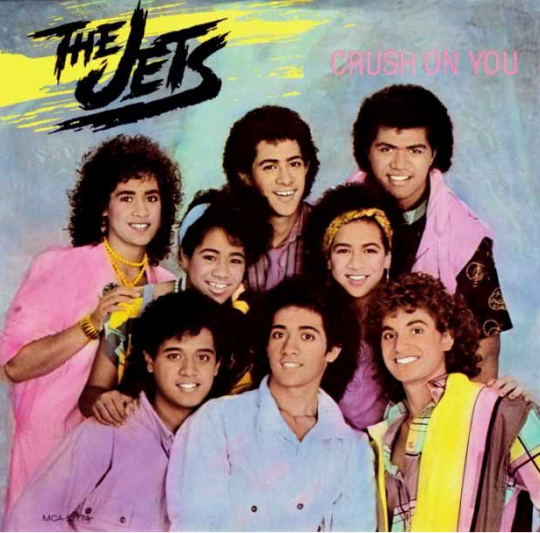
“Crush on You” single by the Jets
The cover of the Jets’ 1985 single “Crush On You.”

Sheila Rankin, Germaine Brooks, and Jerry Hubbard
Sheila Rankin and Germaine Brooks (left to right) at the Flame, with Jerry Hubbard on bass. Photograph by Charles Chamblis, ca. 1985. Used with the permission of the Minnesota Historical Society library.
Holding Location
Articles
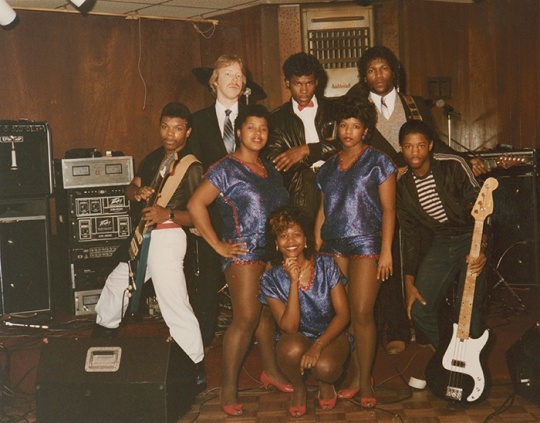
Myst with Network
Myst, later known as Best Kept Secret. Pictured are (front, left to right) Kathleen Johnson, Kym/Mocha Johnson, and Rhonda Johnson with the band Network, including Kirk Johnson (back row, red bow tie). Photograph by Charles Chamblis, ca. 1985. Used with the permission of the Minnesota Historical Society library.
Holding Location
Articles
Related Articles
Turning Point
In the early 1980s, the Minneapolis Sound begins to dominate the charts with its unique blending of genres and infusion of new musical instruments like drum machines and synthesizers. With the release of the movie and album Purple Rain in 1984, Prince and the unique sounds of his hometown of Minneapolis are catapulted into worldwide fame.
Chronology
1967
1970
mid-1970s
1977
1980
1982
1984
1984
1986
1986
1989
1993
2004
2004
2019
Bibliography
Bream, Jon. “Jam & Lewis Say Tyme’s Ryte For New Studio To Take Flyte.” Billboard, October 14, 1989.
——— . “Pop Music: The Rhythm ’n’ Blues Brothers: Jimmy Jam and Terry Lewis Are in Tune with LA and New York Music Scenes—But Keep Churning Out Their Hits From Minnesota.” Los Angeles Times, June 28, 1991.
Cragg, Michael. “The Velvet Rope: How Janet Jackson Inspired An Entire Generation.” The Guardian, October 6, 2017.
https://www.theguardian.com/music/2017/oct/06/velvet-rope-how-janet-jackson-inspired-whole-generation
Harris III, James “Jimmy Jam.” Oral history interview (A2013.353) with Larry Crowe, December 19, 2013. The HistoryMakers Digital Archive. [See especially session 1, tape 1, story 1; and session 1, tape 3, stories 1–7.]
https://www.thehistorymakers.org/biography/james-jimmy-jam-harris-iii
McAdams, Janine. “Jam & Lewis Unveil Their New Recording Complex: Flyte Tyme Studio Lands in Minneapolis.” Billboard, September 30, 1989.
Partridge, Kenneth. “Jimmy Jam Opens Up About the Making of Janet Jackson's 'Rhythm Nation 1814.’” Billboard.com, September 18, 2019.
https://www.billboard.com/articles/news/6258728/jimmy-jam-janet-jackson-rhythm-nation-1814
Prince and Dan Piepenbring, ed. The Beautiful Ones. New York: Spiegel & Grau, 2019.
Roise, Charlene, Elizabeth Gales, Kristen Koehlinger, Kathryn Goetz, and Kristen Zschomler.
Music History, 1850–2000: A Context.” Prepared for the City of Minneapolis, December 2018.
https://www.minneapolismn.gov/resident-services/property-housing/preservation/historic-preservation/theme-studies/music-history
Swensson, Andrea. Got to Be Something Here: The Rise of the Minneapolis Sound. Minneapolis: University of Minnesota Press, 2017.
Twin Cities Funk and Soul newspaper, multiple issues.
https://secretstashrecords.com/news/TwinCitiesFunkAndSoulNewspaperWeb.pdf
Zschomler, Kristen. “Prince, 1958–1987: Multiple Property Document Form.” State Historic Preservation Office, St. Paul.
https://mn.gov/admin/assets/Prince%20MPDF_tcm36-445058.pdf
Related Resources
Primary
Beaulieu, Allen. Prince: Before the Rain. St. Paul: Minnesota Historical Society Press, 2018.
Chamblis, Charles, and Davu Seru. Sights, Sounds, and Soul: The Twin Cities Through the Lens of Charles Chamblis. St. Paul: Minnesota Historical Society Press, 2017.
















